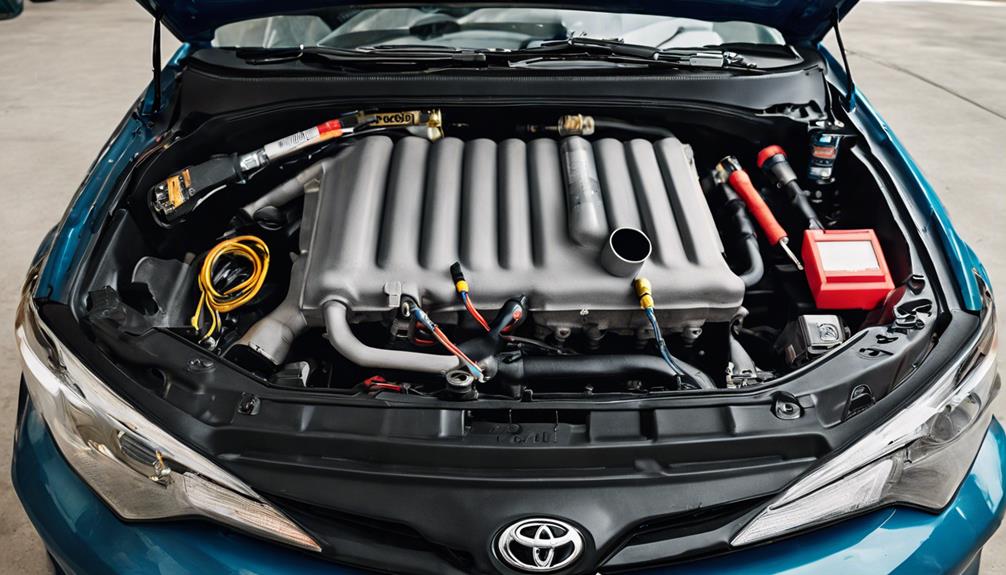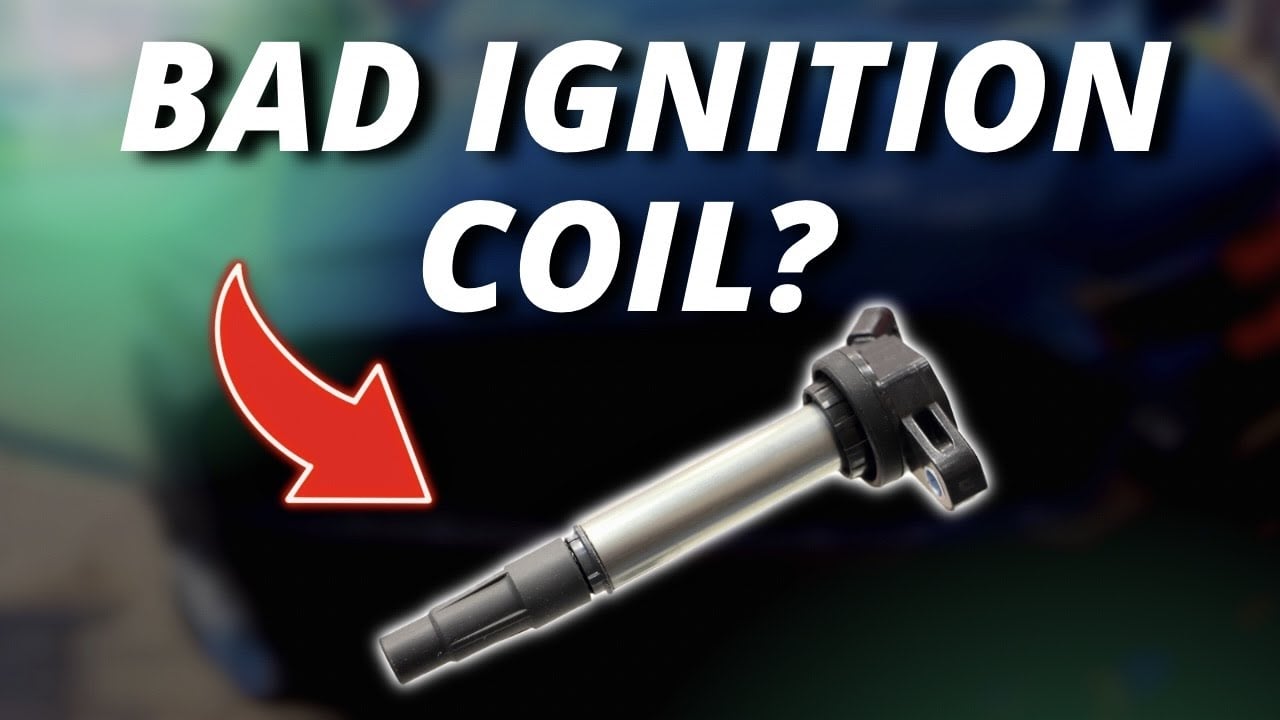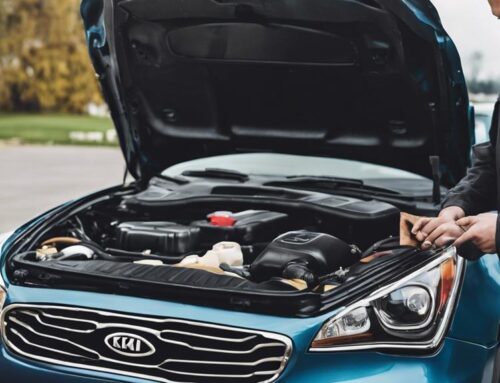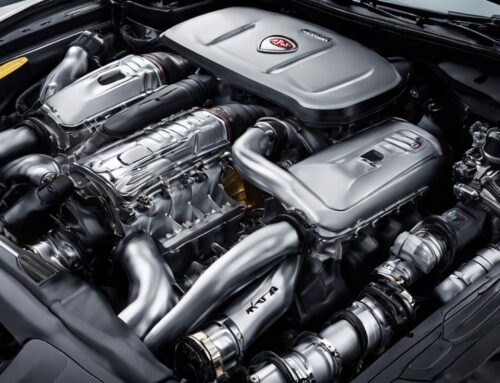To fix ignition issues in your Toyota Corolla, start by inspecting the ignition coils for any signs of wear or damage. Replacing faulty spark plugs can greatly improve performance. Clean the ignition contacts to guarantee a good connection. Check the ignition timing to make sure it's correctly set. It's also wise to test the ignition switch if you're experiencing starting problems. If you're looking for upgrades, consider high-quality ignition components. Finally, resetting the ECU can optimize your vehicle's performance. Dive further to explore these steps in more detail and make sure a smooth-running Corolla.
Key Takeaways
- Inspect ignition coils for wear, corrosion, and proper resistance, replacing any faulty coils to ensure reliable performance.
- Replace faulty spark plugs with Denso FC20HR-Q8 plugs, ensuring correct gap and proper torque to 15 foot-pounds.
- Regularly clean ignition contacts using dielectric grease and contact cleaner to prevent misfires and ensure solid electrical connections.
- Test the ignition switch for consistent voltage readings across different key positions, replacing it if any issues are detected.
- Reset the ECU by disconnecting the battery for 30 minutes to optimize engine performance and enhance the driving experience.
Inspecting Ignition Coils
When examining ignition coils in your Toyota Corolla, look for signs of wear like cracks, carbon tracks, or corrosion. These indicators suggest that the ignition coils might not be functioning at their best, potentially leading to misfires or poor engine performance. Beyond visual inspection, you should also check for oil contamination on the coils. Oil can seep into the coils, causing them to malfunction or degrade faster.
Next, use a multimeter to measure the resistance of the coils. Make sure the readings are within the specified range provided in your vehicle's service manual. If the resistance is off, it's a clear sign that the coil may be faulty and needs further attention.
Confirm that all electrical connections to the ignition coils are secure and free of corrosion. Loose or corroded connections can disrupt the electrical flow, leading to ignition issues. Additionally, ensure that the coils are firmly mounted in their positions. A loose coil can lead to poor contact and erratic engine behavior.
If you suspect a specific coil is problematic, consider swapping it with another cylinder's coil. This method can help you pinpoint the faulty coil by observing if the problem follows the coil. Taking these steps guarantees your ignition system runs smoothly and reliably.
Replacing Faulty Spark Plugs
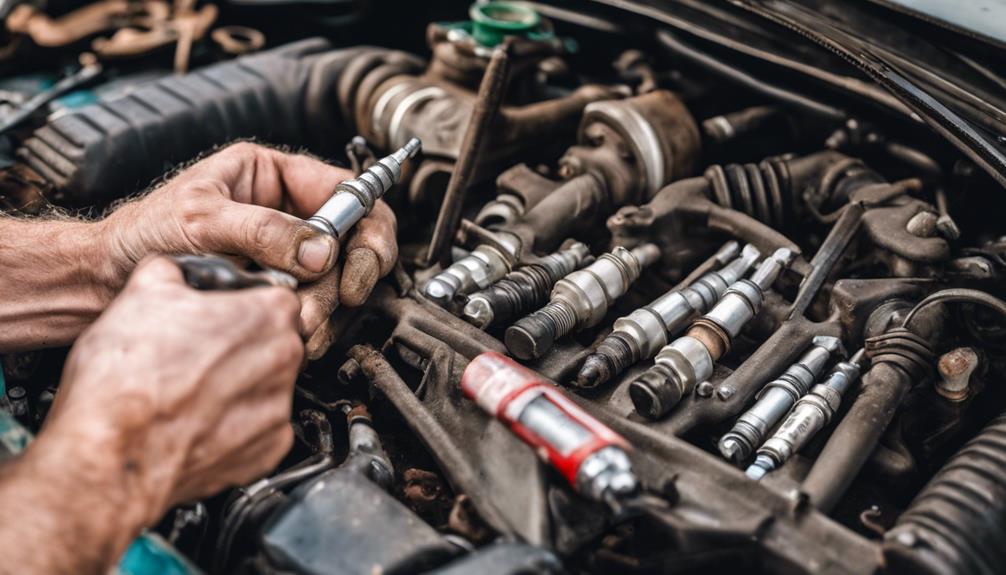
After inspecting the ignition coils, the next step in maintaining your Toyota Corolla's ignition system is replacing faulty spark plugs. For the Corolla XSE with a 2.0 L engine, you should use Denso FC20HR-Q8 plugs. Start by gathering a 14 mm spark plug socket or a 14 mm socket for removal and installation.
Before you install the new spark plugs, inspect them closely for any cracks and verify the correct gap. Applying a small amount of antiseize on the threads can make future removal easier. Insert the new spark plug carefully and hand-tighten it to avoid cross-threading.
Next, use a torque wrench to tighten the spark plug to 15 foot-pounds. Proper torque is critical; over-tightening can damage the threads, while under-tightening might cause performance issues. Once torqued correctly, double-check that everything is secure.
Checking Ignition Timing
To check the ignition timing on your Toyota Corolla, you'll need a timing light and a clear understanding of the engine's timing marks. Start by consulting your vehicle's service manual to find the recommended ignition timing specifications for your specific model. This guarantees you're aiming for the correct settings.
First, locate the timing marks on the crankshaft pulley and the timing cover. Next, connect the timing light's power leads to the battery and the inductive pickup to the number one spark plug wire. Start your engine and let it warm up to its normal operating temperature.
With the engine running, aim the timing light at the timing marks. You'll see a strobe effect, illuminating the marks so you can compare them with the reference point. If the marks are aligned, your timing is set correctly. If not, you'll need to adjust it according to the manual's instructions.
Incorrect ignition timing can cause engine knocking, poor performance, and potential damage. By ensuring the spark plugs fire at the right moment, you maintain peak engine performance, fuel efficiency, and emission control. This critical step keeps your Corolla running smoothly and efficiently.
Cleaning Ignition Contacts
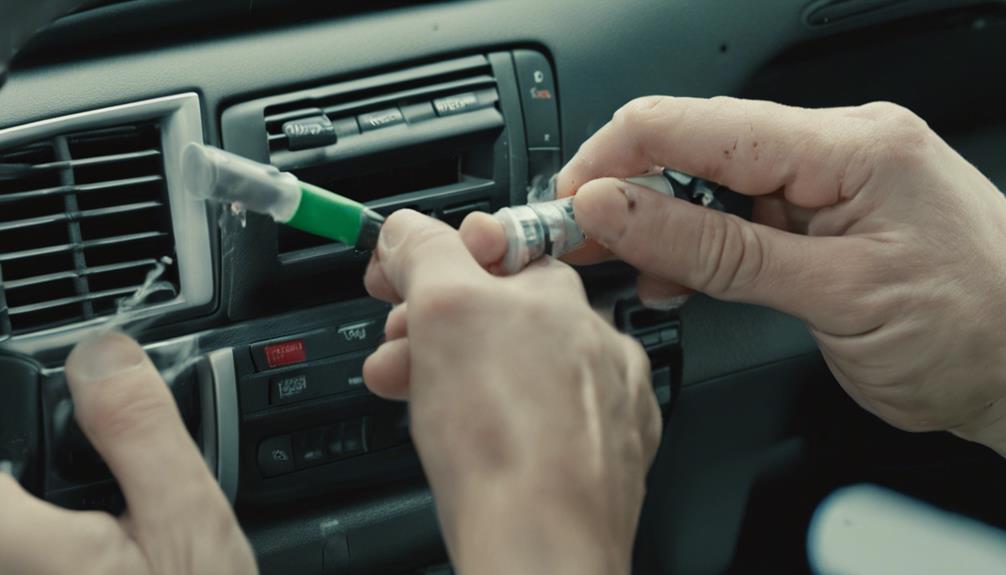
When cleaning the ignition contacts on your Toyota Corolla, you'll need a contact cleaner or rubbing alcohol and a soft brush. Start by gathering these tools and following a step-by-step procedure to guarantee a thorough clean. Regular cleaning can also help prevent future ignition issues, keeping your car running smoothly.
Necessary Cleaning Tools
Start by gathering essential cleaning tools like dielectric grease, a small wire brush, and lint-free cloths to clean the ignition contacts effectively. Having the right tools guarantees you can tackle the job with precision and confidence. Dielectric grease is vital for preventing future corrosion and maintaining a solid electrical connection. The small wire brush helps you gently remove any debris or corrosion without damaging the delicate components of your ignition system. Lint-free cloths are perfect for wiping away any residue, ensuring a clean and professional finish.
Here's a quick checklist to make sure you're ready:
- Dielectric Grease: Prevents future corrosion and maintains electrical connections.
- Small Wire Brush: Removes debris and corrosion without causing damage.
- Lint-Free Cloths: Ensures a clean, residue-free finish.
Step-by-Step Procedure
Begin the cleaning process by disconnecting the battery to guarantee safety while working on the ignition system. Next, locate the ignition coil and carefully remove it from its position. You'll want to use a contact cleaner or rubbing alcohol to clean the coil connection points thoroughly. Apply the cleaner to a lint-free cloth or a small brush, then gently scrub away any buildup or corrosion on the contacts.
After cleaning, inspect the contacts to make sure all debris is removed. It's essential for the contacts to be entirely free of any dirt or oxidation to improve electrical conductivity and prevent misfires. Once satisfied with the cleanliness, allow the contacts to dry completely. This step is crucial as any remaining moisture can interfere with the ignition system's performance.
Reassemble the ignition system by securely placing the ignition coil back into its original position. Double-check that everything is correctly connected before reconnecting the battery. Regularly cleaning your ignition contacts can help maintain peak performance and ensure your Toyota Corolla runs smoothly. By taking control of this straightforward maintenance task, you can extend the life of your ignition system and reduce the risk of future issues.
Preventing Future Issues
To guarantee future ignition issues are prevented, regularly clean the contacts to ensure peak performance and reliability. Dirty or corroded contacts can lead to misfires and poor electrical connections, which hinder your ignition coil's function. By taking control and keeping these contacts clean, you can make certain your Toyota Corolla starts reliably and runs smoothly.
Cleaning the ignition contacts is simple yet effective. Use a contact cleaner or an alcohol-soaked cloth to gently clean them without causing any damage. This straightforward maintenance step not only improves engine performance but also extends the lifespan of your ignition components.
Here are three compelling reasons to keep those contacts clean:
- Prevent Misfires: Clean contacts ensure strong electrical connections, reducing the risk of misfires that can affect your engine's performance and reliability.
- Save on Maintenance Costs: Regular cleaning can prevent more significant issues, saving you money on potential repairs and replacements down the line.
- Extend Component Lifespan: Proper maintenance extends the life of your ignition components, meaning fewer replacements and less hassle.
Testing the Ignition Switch
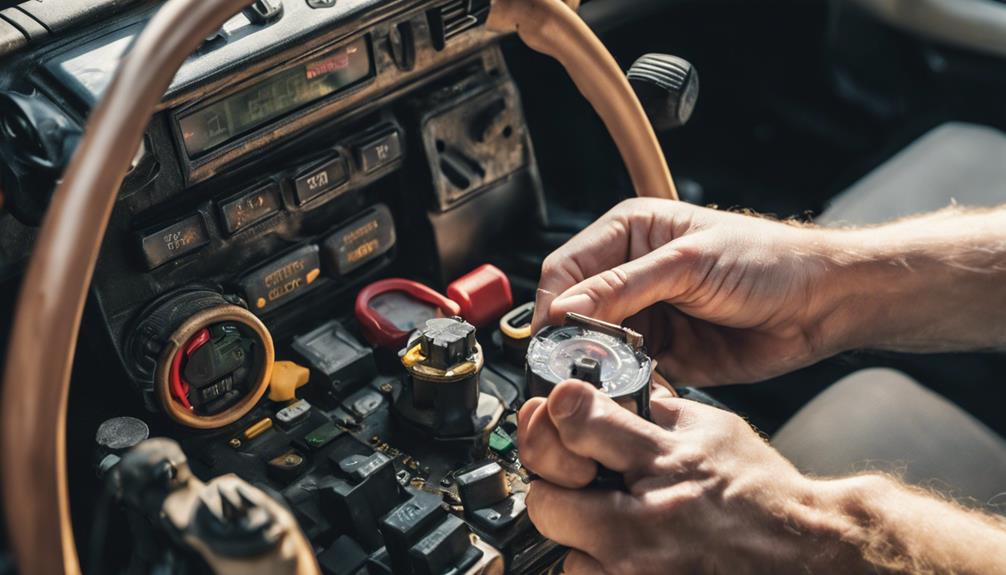
To test your Toyota Corolla's ignition switch, you'll need some basic tools like a multimeter. Start by recognizing common symptoms such as difficulty turning the key or flickering dashboard lights. Follow a step-by-step guide to guarantee proper diagnosis and pinpoint any ignition-related issues.
Common Ignition Switch Symptoms
Experiencing difficulty starting your Toyota Corolla or noticing intermittent power loss can be signs of a faulty ignition switch. When you encounter these issues, it's important to understand the common symptoms to regain control over your vehicle's performance. Here are the top indicators that your ignition switch might be the culprit:
- Engine Won't Start Consistently: If your Corolla's engine struggles to start or only starts intermittently, the ignition switch may not be sending the proper signals.
- Intermittent Power Loss: Notice your car suddenly losing power while driving? A failing ignition switch can cause sporadic power interruptions, posing serious safety risks.
- Electrical Component Failures: Problems with your dashboard lights, radio, or other electrical components can also point to ignition switch issues.
Testing the ignition switch involves checking for power at different key positions using a multimeter. Ensuring the switch has consistent voltage readings is important. If it fails this voltage test, replacing the ignition switch might be necessary to restore your Corolla's functionality. Don't let these symptoms linger; they can escalate into more significant problems. Consult your vehicle's manual or seek professional help to accurately diagnose and address these issues promptly. Taking charge of these symptoms early on will keep your Corolla running smoothly and safely.
Tools and Equipment Needed
When facing ignition switch issues in your Toyota Corolla, having the right tools and equipment is key to effective troubleshooting and repair. First and foremost, you'll need a reliable multimeter to measure electrical continuity. This device is essential for identifying whether the ignition switch is functioning correctly or if it's the source of your starting or electrical issues.
A wiring diagram specific to your Toyota Corolla model is another vital tool. This diagram will help you accurately locate the ignition switch wires, ensuring you're testing the right components. You can usually find this in the vehicle's service manual or through a quick online search tailored to your Corolla's year and model.
Before you start testing, always prioritize safety by disconnecting the car battery. This simple step protects you from electrical shocks and prevents any accidental short circuits. Additionally, as you work, properly label all wires and components. This practice will make reassembly much easier and help you avoid any confusion down the line.
Step-by-Step Testing Process
Start by locating the ignition switch in your Toyota Corolla to begin the testing process. It's typically situated behind the steering column cover. Remove this cover carefully to access the switch. Once you've got it in sight, grab your multimeter.
First, set the multimeter to measure continuity. You'll want to check the switch's internal circuits to make sure they're functioning correctly. Follow these steps:
- Check for Power: Connect the multimeter probes to the ignition switch terminals. With the key in the 'ON' position, verify that power is reaching the switch. If there's no power, you've likely found your problem.
- Test for Continuity: With the key in various positions (OFF, ACC, ON, START), check for continuity between the terminals as specified in your Corolla's service manual. No continuity means the switch is faulty.
- Signal Verification: Make sure the switch is sending signals to the starter and other electrical components. If the signals are inconsistent or absent, the ignition switch might need replacing.
Upgrading Ignition Components
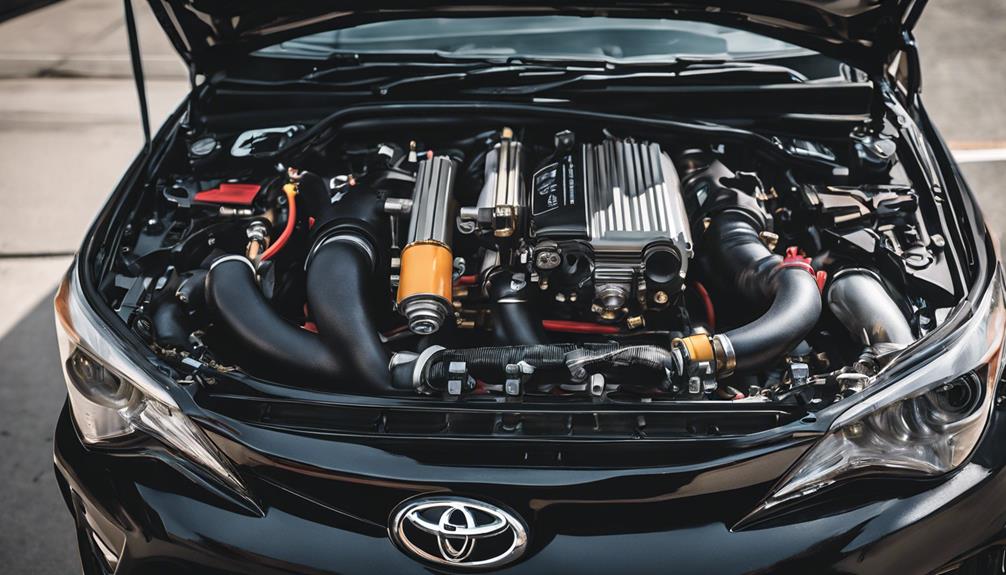
Upgrading your Toyota Corolla's ignition components can greatly enhance engine performance and fuel efficiency. By making strategic improvements, you can guarantee your vehicle runs smoother and more reliably. Start by considering OEM Denso ignition coils. These are specifically designed for your Corolla, offering unmatched reliability and longevity. Replacing your current coils with these will provide a more consistent spark, which translates to better engine performance.
Next, take a look at your spark plugs. Upgrading to high-quality options like Denso FC20HR-Q8 spark plugs can greatly enhance ignition efficiency. These plugs are designed to deliver a more powerful spark, ensuring complete combustion and, consequently, better fuel economy and reduced emissions.
Don't forget about your headlights! While not directly related to ignition, better visibility is essential for overall safety. Swapping to aftermarket LED headlights from oxo.com can make a substantial difference. These LEDs offer superior brightness and longevity compared to traditional halogen bulbs. Plus, you can use the promo code 'gearmo Auto' for a 15% discount, making this upgrade even more appealing.
Resetting the ECU
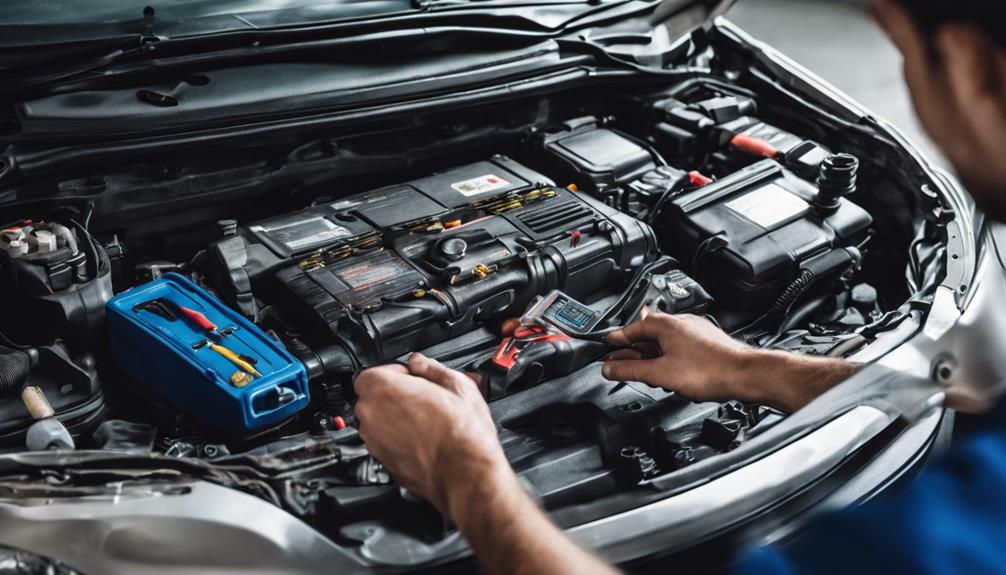
Resetting the ECU in your Toyota Corolla can optimize engine performance and guarantee your new ignition components function correctly. By clearing stored error codes and allowing the system to adapt to new components, you can enhance your driving experience and keep your car running smoothly.
To reset the ECU, follow these steps:
- Disconnect the Battery: Unplug the negative terminal of the battery for at least 30 minutes. This action allows the ECU to fully reset.
- Reboot the System: After the waiting period, reconnect the battery terminal. The system will reboot, and the ECU will start fresh.
- Consult Your Owner's Manual: Always refer to your vehicle's owner's manual for specific instructions related to your Toyota Corolla model. This ensures you're following the correct procedure.
Taking control of your vehicle's performance means understanding the importance of an ECU reset, especially after replacing ignition components. This simple yet effective process can lead to noticeable improvements in engine performance, fuel efficiency, and throttle response. Aiming for precision, you'll gain the confidence that your vehicle is functioning at its best. Resetting the ECU isn't just a maintenance task—it's a way to reclaim the best possible performance from your Toyota Corolla.
Frequently Asked Questions
Can a Faulty Ignition Affect My Toyota Corolla's Fuel Efficiency?
A faulty ignition can wreak havoc on your Toyota Corolla's fuel efficiency. Imagine throwing money out the window every time you drive. Misfires and incomplete combustion caused by worn-out coils or spark plugs make your car guzzle more gas than necessary. To take control, regularly maintain your ignition system. Promptly addressing issues keeps your Corolla running smoothly and saves you a fortune on fuel.
What Are Common Signs of Ignition System Problems in a Toyota Corolla?
You might notice common signs of ignition system problems in your Toyota Corolla, such as engine misfires, rough idling, or decreased fuel efficiency. Difficulty starting the engine, jerking during acceleration, and stalling are other red flags. Pay attention to engine vibration, backfiring, and a lack of responsiveness when pressing the gas pedal. If you experience these issues, it's time to inspect your ignition system components. Stay vigilant to maintain control.
How Often Should I Service My Toyota Corolla's Ignition System?
Think of your Toyota Corolla's ignition system like the heartbeat of your car. You should service it every 30,000 to 60,000 miles for peak performance. Regular maintenance, including checking spark plugs, ignition coils, and spark plug wires, keeps your ride smooth and efficient. Always consult your owner's manual for specifics, but staying proactive guarantees you control your car's reliability and longevity.
Are There Any Recalls Related to Toyota Corolla Ignition Issues?
Yes, there are recalls related to Toyota Corolla ignition issues. Specifically, the 2019-2020 Corolla Hatchback models experienced faulty ignition coils. Over 180,000 vehicles were affected, causing engine misfires or stalling. Toyota notified owners and provided free replacements. Be sure you're checking for recalls regularly and addressing them promptly to guarantee your vehicle's safety and performance. Stay proactive and schedule any necessary repairs immediately.
Can Weather Conditions Impact the Performance of My Corolla's Ignition System?
Absolutely, weather conditions can impact your Corolla's ignition system. In extreme cold, ignition coils work harder, which can cause misfires or hard starts. Excessive heat speeds up coil breakdown or leads to premature failure of ignition components. Humid conditions result in moisture buildup, affecting spark plug performance and causing misfires. Stay in control by performing regular maintenance, including checking and replacing worn components to mitigate these weather-related issues.

